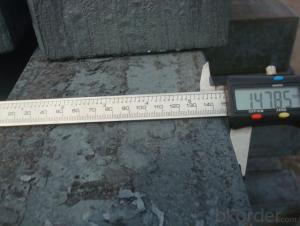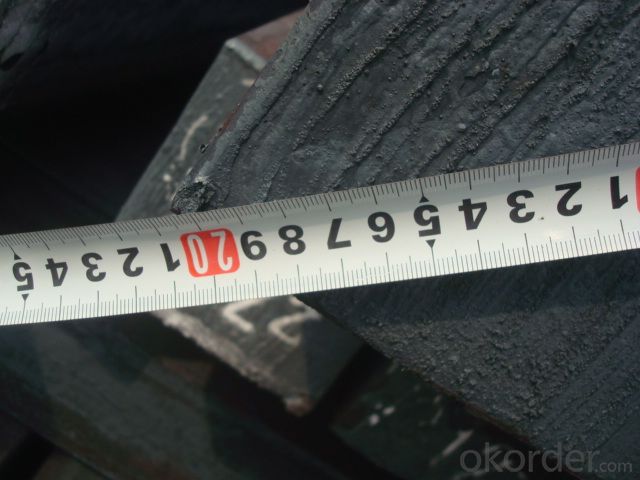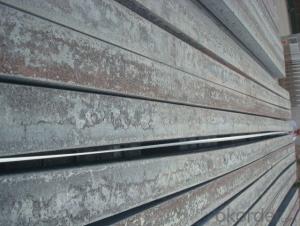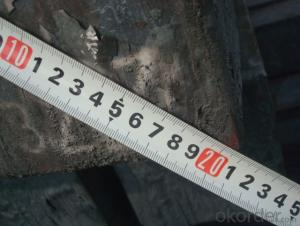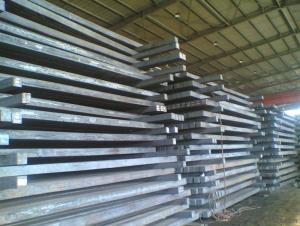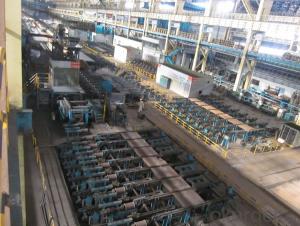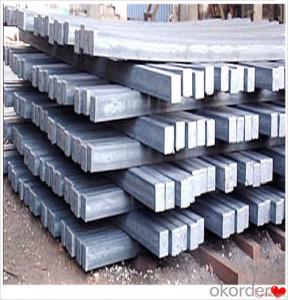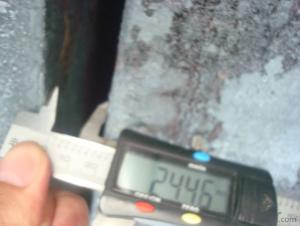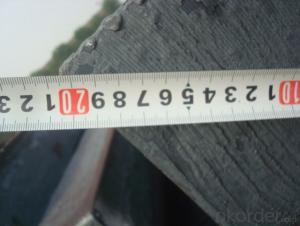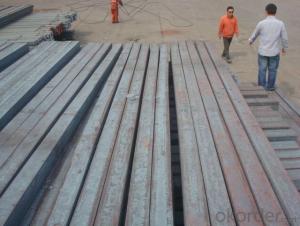Steel Bloom/Billet Manufactured by Blast Furnace by Continue Casting Making
- Loading Port:
- Tianjin
- Payment Terms:
- TT OR LC
- Min Order Qty:
- 1000 m.t.
- Supply Capability:
- 10000 m.t./month
OKorder Service Pledge
OKorder Financial Service
You Might Also Like
Steel Bloom/Billet Manufactured by Blast Furnace by Continue Casting Making
1.Structure of Steel Bloom/Billet Manufactured by Blast Furnace by Continue Casting Making
Steel Billets Manufactured by Continue Casting is the raw material of all kinds of steel mill. Billet section of square, round, flat, rectangular and abnormity, etc Several, mainly related to shape of rolled products. Simple rolled section steel, choose cross section of square billet or rectangular billet. rolling The sector products such as flat steel, Angle steel, select the rectangular billet or slab. Had better profiled billet when production beams, channels, and in rolling process Lines and improve the yield. The raw material of round billet is the production of seamless tube.
2.Main Features of Steel Bloom/Billet Manufactured by Blast Furnace by Continue Casting Making.
.
There are three shapes of the steel billets: square billet, slab, rectangular billet The Chinese billet, rectangular billet is mainly suitable for rolling hot rolled strip, building reinforced bar, Ordinary wire, high speed wire rod and various small profile. Of the slab are mainly used for rolling plate and hot coil sheet.
3. Steel Bloom/Billet Manufactured by Blast Furnace by Continue Casting Making Images
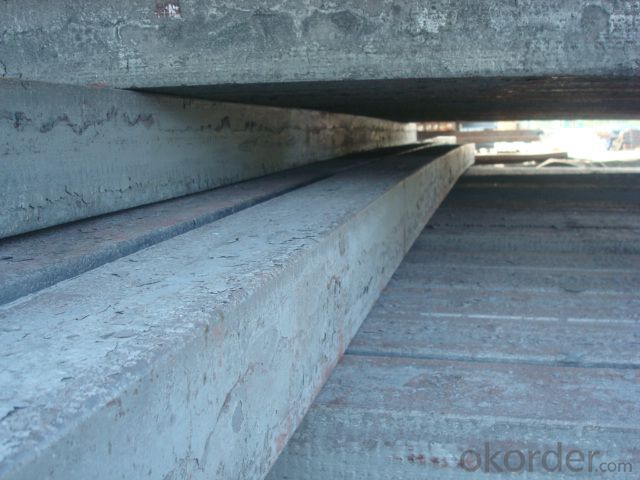
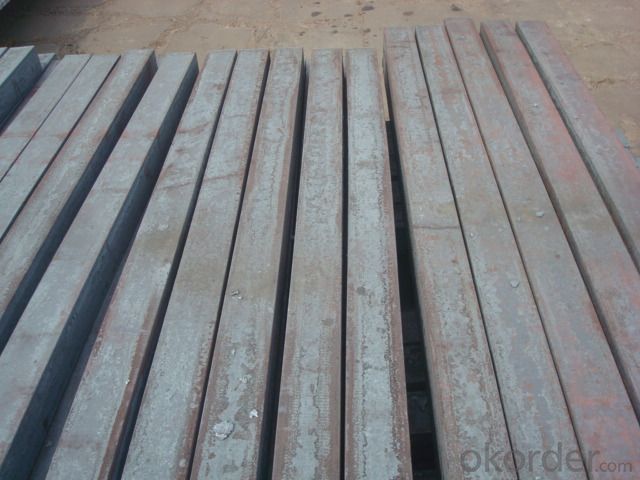
4. Steel Bloom/Billet Manufactured by Blast Furnace by Continue Casting MakingSpecification
Material standard The editor Range of thickness: 150-240 - mm + / - 5 mm width range: 880-1530 - mm + / - 20 mm Length: 3700-10000 - mm + / - 500 - mm Cross-sectional size: 64 * 64; 82 * 82; 98 * 98; 124 * 124; 120 * 150; 152 * 164; 152 * 170 mm Length: 9000 mm Section of tolerance: billet: 1.0 + / - 2.0-1.0 + / - 1.0 mm slab: width: + / - 2.0 mm thickness: + / - 3.0 mm The length tolerance: + / - 200 mm Section diagonal tolerance: 3.5-8.0 MM Billet section size protrusions requirements: < 1242 mm, do not allow; > = 1242 mm, < = 2 mm 1242 mm, < = 3 mm Beheading (shear) extension deformation: < 1242 mm billet: no control; The slab: < = 15 mm Surface tilt: no more than billet section 0.1 Bending: every 1 m length is not more than 10 mm The distortion: length < = 5 m, < = 11. ; The length of the < = 7.5 M, < = 5. Material % 3 sp/PS chemical composition: C Mn Si S P
5.FAQ of Steel Bloom/Billet Manufactured by Blast Furnace by Continue Casting Making
We have organized several common questions for our clients,may help you sincerely:
①How about your company?
A world class manufacturer & supplier of castings forging in carbon steel and alloy steel,is one of the large-scale professional investment casting production bases in China,consisting of both casting foundry forging and machining factory. Annually more than 8000 tons Precision casting and forging parts are exported to markets in Europe,America and Japan. OEM casting and forging service available according to customer’s requirements.
②Inclusions in the continuous casting billet come from? Found in the continuous casting billet of inclusion complex, forms.Judging from the inclusion of ingredients, can be roughly know the source of inclusions. (1) the weak deoxidizing elements contained in the inclusion is more, and SiO2 + MnO content greater than 60%, the size is more than 50 microns, which can determine the inclusions are caused by air and molten steel secondary oxidation; (2) inclusion composition and refractory materials, with special shape, size is larger, can determine for refractory erosion;(3) inclusion contains such elements as potassium, sodium, is due to mould protection slag in molten steel.
③What is the advantage of the continue Casting steel billet comparing to the die casting steel billet?
Compared with die casting, continuous casting has the advantages of: 1. To simplify the Steel billet The production process 2. Improve the metal yield 3. Improve the quality of the billet 4. Reduces the steel worker's labor intensity 5. Save energy and reduce consumption
Steel billet is produced by the method of through three processes: It is through the steelmaking system of continuous casting equipment, directly by the molten steel pouring into billet; The second is the steelmaking system in the production of steel ingot casting billet through system of steel rolling rolling equipment or processing of steel semi-finished products; Three is the steelmaking system production of steel ingot by forging the semi-finished product processing equipment.
- Q: Can steel billets be used for making cutlery?
- Steel billets have the potential to be utilized in the creation of cutlery. These billets serve as the primary substance in the manufacturing of a variety of steel commodities, which encompass cutlery. Once heated, the billets are then transformed into desired forms, such as knives, forks, or spoons, through methods like forging or casting. The resultant steel cutlery possesses notable attributes such as strength, durability, and the ability to maintain a sharp edge. Nevertheless, it is important to recognize that the specific kind of steel employed and the manufacturing procedures substantially influence the quality and characteristics of the cutlery.
- Q: What are the safety precautions in handling steel billets?
- To prevent accidents and injuries, it is necessary to adhere to specific safety precautions when handling steel billets. Some of the essential precautions include: 1. Personal Protective Equipment (PPE): Always wear appropriate PPE, such as safety goggles, gloves, steel-toed boots, and protective clothing. This will safeguard against potential hazards like sharp edges, falling objects, and flying debris. 2. Lifting Techniques: Employ proper lifting techniques, such as bending the knees and using the legs to lift. This will help avoid strains or injuries to the back. If the billets are too heavy to lift manually, utilize mechanical lifting equipment like cranes or forklifts. 3. Secure Storage: Ensure that steel billets are stored securely and stably. This will prevent them from toppling or rolling, which can lead to injuries or damage to equipment and infrastructure. To keep the billets organized and secure, employ suitable storage racks, bins, or pallets. 4. Handling Tools: Safely handle steel billets using appropriate tools such as lifting hooks, clamps, or tongs. Avoid using your hands or body to move or reposition the billets, as this can result in pinching, crushing, or cutting injuries. 5. Clear and Well-Defined Work Area: Maintain a work area around the steel billets that is clear and well-defined. This will prevent tripping hazards. Remove any obstructions or debris that could cause slips, trips, or falls. 6. Communication and Training: Ensure that all personnel involved in handling steel billets receive sufficient training in safe handling procedures and are aware of potential hazards. Establish clear communication channels to coordinate movements and actions, especially when using machinery or working in teams. 7. Inspection and Maintenance: Regularly inspect the condition of the steel billets, lifting equipment, and storage racks to identify any potential safety issues. Promptly address any defects, damages, or signs of wear and tear to prevent accidents. 8. Emergency Procedures: Establish emergency procedures and ensure that all personnel are familiar with them. This includes procedures for handling accidents, injuries, spills, or other emergencies that may occur during the handling of steel billets. By adhering to these safety precautions, the risk of accidents and injuries can be minimized, creating a safer working environment for those involved in handling steel billets.
- Q: What are the different types of steel billet casting methods?
- Steel billet casting employs various techniques, each boasting its own merits and applications. Among the most prevalent approaches are continuous casting, static casting, and centrifugal casting. 1. Continuous Casting: As the most extensively employed method, continuous casting entails pouring molten steel into a water-cooled mold. Within this mold, the steel solidifies into an uninterrupted strand, subsequently divided into desired lengths by a cutting apparatus. Continuous casting enables high production rates and consistent quality, rendering it optimal for mass production of steel billets. 2. Static Casting: Also referred to as ingot casting, this technique involves pouring molten steel into an immobile mold, which facilitates solidification into a solid billet. Typically composed of sand or metal, the mold allows for controlled solidification, enabling the attainment of desired properties. Static casting finds application in smaller production runs or when specific alloy compositions or shapes are required. 3. Centrifugal Casting: Employing centrifugal force, this method ensures the even distribution of molten steel within a rotating mold. As the mold spins, the molten steel is propelled towards the mold walls, resulting in a uniform casting with enhanced density and mechanical properties. Centrifugal casting is frequently employed for large and intricate billets, such as those indispensable in pipe manufacturing or turbine components. Although these represent the principal techniques employed in steel billet casting, variations or combinations of these methods may exist, contingent upon specific requirements or technological advancements.
- Q: Can steel billets be recycled?
- Yes, steel billets can be recycled. Steel is a highly recyclable material, and the recycling process involves melting down the steel billets to create new steel products, reducing the need for raw materials and conserving energy.
- Q: What are the different types of steel billet forging defects?
- During the forging process, various steel billet forging defects may arise, each with its own causes and potential impact on the final forged product's quality and integrity. The common defects encompass the following: 1. Surface cracks, resulting from excessive heating or cooling, improper forging techniques, or the presence of impurities in the steel, manifest as cracks on the billet's surface. 2. Internal voids, caused by incomplete mold filling, inadequate venting, or trapped gases within the steel, form cavities or voids within the billet. 3. Inclusions, consisting of foreign materials or impurities within the billet, like non-metallic particles (e.g., oxides or sulfides) or metallic impurities (e.g., slag), can weaken the steel structure and diminish overall quality. 4. Segregation, which occurs during the cooling process, refers to the uneven distribution of alloying elements within the billet, leading to different mechanical properties in distinct areas of the steel and resulting in inconsistencies in the final product. 5. Dimensional inaccuracies, arising from improper tooling or die design, inadequate heating or cooling processes, or improper handling during forging, refer to deviations from the desired shape or size of the billet. 6. Grain structure abnormalities, influenced by factors such as improper heating or cooling rates, can weaken the steel and reduce its mechanical properties by altering the grain structure. To ensure the quality and reliability of the final forged product, it is crucial to detect and address these defects during the production process. Quality control measures, including non-destructive testing and visual inspections, can aid in identifying and rectifying these defects before delivering the finished product to the customer.
- Q: What is the active carbon. What is the difference with the charcoal?
- Activated carbon activated carbon after activation of the solid carbon black porous. A general powder, granular or pellet, carbon as a main component, also containing a small amount of oxygen, hydrogen, nitrogen, sulfur and chlorine. The early production of activated carbon as raw materials for wood, hard shell or animal bone, later used by coal production method a: the steam and gas activation method. The use of water vapor or carbon dioxide at 850 ~ 900 C carbon activation.
- Q: What are the different types of steel billet heat treatment processes?
- There are several types of steel billet heat treatment processes that are commonly used in the industry. These processes aim to improve the mechanical properties of the steel billets, such as strength, hardness, toughness, and ductility, to meet specific application requirements. Some of the different types of steel billet heat treatment processes include: 1. Annealing: This process involves heating the steel billet to a specific temperature and then slowly cooling it to room temperature. Annealing helps to relieve internal stresses and improve the machinability and ductility of the steel. 2. Normalizing: In this process, the steel billet is heated to a temperature above its critical point and then allowed to cool in still air. Normalizing refines the grain structure of the steel, resulting in improved mechanical properties and uniformity. 3. Quenching: Quenching involves rapidly cooling the steel billet from a high temperature by immersing it in a quenching medium, such as water, oil, or polymer. This process creates a hardened structure in the steel, increasing its hardness and strength. 4. Tempering: After quenching, the steel billet is heated to a lower temperature and then cooled slowly. Tempering reduces the brittleness caused by quenching and improves the toughness, ductility, and machinability of the steel. 5. Austempering: This process involves quenching the steel billet to a temperature just above the martensite transformation range and holding it at that temperature until it transforms to bainite. Austempering results in a structure with improved strength, toughness, and wear resistance. 6. Martempering: Martempering is similar to austempering, but the steel billet is quenched into a medium at a temperature slightly above the martensite transformation range and then held until it cools to below that temperature. This process produces a structure with improved toughness and reduced distortion compared to conventional quenching. These are just a few of the many heat treatment processes used for steel billets. The choice of process depends on the desired mechanical properties and application requirements of the steel.
- Q: What are the factors that affect the mechanical properties of steel billets?
- The mechanical properties of steel billets are influenced by several factors. These factors include the chemical composition, heat treatment, microstructure, grain size, processing conditions, surface condition, and environmental factors. 1. Chemical composition: The mechanical properties of steel billets are determined by the levels of carbon, manganese, silicon, and other alloying elements in the steel. These elements impact the strength, hardness, and ductility of the billets. 2. Heat treatment: By controlling the temperature and duration of heating and cooling, the mechanical properties of steel billets can be significantly altered. Techniques like annealing, quenching, and tempering can enhance the hardness, toughness, and overall strength of the steel. 3. Microstructure: The mechanical properties of steel are greatly influenced by its microstructure, which is determined by factors like cooling rate and alloying elements. Different phases, such as ferrite, pearlite, and martensite, affect the strength, ductility, and toughness of the billets. 4. Grain size: The size and distribution of grains in the steel billets have an impact on their mechanical properties. Finer grain sizes generally result in improved strength and toughness, while larger grain sizes may lead to reduced mechanical properties. 5. Processing conditions: The mechanical properties of steel billets are influenced by the processing conditions during production, such as temperature and rate of deformation. Techniques like rolling, forging, and extrusion affect the grain structure and overall mechanical behavior of the steel. 6. Surface condition: The mechanical properties of steel billets can be significantly affected by the surface condition, including the presence of defects like cracks, voids, or surface contamination. Surface defects act as stress concentration points and reduce the overall strength and integrity of the steel. 7. Environmental factors: The mechanical properties of steel billets can be influenced by environmental conditions like temperature, humidity, and exposure to corrosive substances. Corrosion can decrease strength and structural integrity, while high temperatures can cause softening or thermal degradation of the steel. Considering these factors is crucial in the design and manufacturing of steel billets to ensure that the desired mechanical properties are achieved for specific applications.
- Q: What is a steel billet?
- A steel billet is a semi-finished product that is created through the process of casting molten steel into a rectangular shape. It typically has a square or rectangular cross-section and is often used as a starting material for various steel products. The size of a steel billet can vary depending on its intended use, but it is typically around 100mm to 200mm square in cross-section and several meters long. Once produced, steel billets are further processed through rolling or extrusion to create different shapes such as bars, rods, wires, or structural steel sections. Steel billets are widely used in the manufacturing industry as a raw material for the production of a wide range of steel products used in construction, automotive, machinery, and many other sectors.
- Q: What are the advantages of using steel billets in manufacturing?
- There are several advantages of using steel billets in manufacturing. Firstly, steel billets are highly versatile and can be easily shaped into various forms, making them suitable for a wide range of applications. Secondly, steel billets have excellent strength and durability, ensuring the final products made from them are strong and long-lasting. Additionally, steel billets have good resistance to corrosion and can withstand high temperatures, making them ideal for use in harsh environments. Lastly, steel billets are readily available and cost-effective, making them a preferred choice for many manufacturers.
Send your message to us
Steel Bloom/Billet Manufactured by Blast Furnace by Continue Casting Making
- Loading Port:
- Tianjin
- Payment Terms:
- TT OR LC
- Min Order Qty:
- 1000 m.t.
- Supply Capability:
- 10000 m.t./month
OKorder Service Pledge
OKorder Financial Service
Similar products
Hot products
Hot Searches
Related keywords
